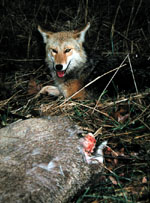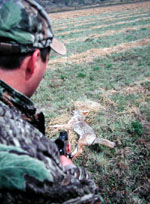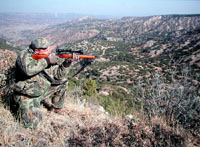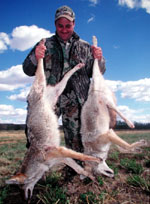
|
Features
|
|
|
|
Books
|
|
|
|
Fun & Games
|
|
|
|
Contact Us
|
|
|
John's Journal... Entry 143, Day 5
SUNTANS AND COYOTES
Ken Allein On Coyote Calling
 EDITOR'S
NOTE: If you hunt coyotes at this time of year, not only will you
get a suntan instead of frostbite, but the tactics you use will change.
Because you'll deal with older animals, you can use territorial calls
and pup calls along with distress calls. Here's what three of the nation's
leading coyote hunters say about the techniques they use to take the song
dogs during the long, hot days of summer.
EDITOR'S
NOTE: If you hunt coyotes at this time of year, not only will you
get a suntan instead of frostbite, but the tactics you use will change.
Because you'll deal with older animals, you can use territorial calls
and pup calls along with distress calls. Here's what three of the nation's
leading coyote hunters say about the techniques they use to take the song
dogs during the long, hot days of summer.
Ken Allein of Delevan, New York, hunts coyotes all over the nation year-round as a member of the Quaker Boy Calls Pro Staff. "I've been hunting coyotes and foxes for about 18 years," Allein said. "And one of the big differences I've noticed in hunting the summer song dogs is that they are much more territorial. During the winter months, I primarily call coyotes to feed or to breed. To call them effectively in the summer months, I challenge their paternal and maternal instincts." Allein considers coyotes easier to call in the summer months because of their territorial tendency. "If you blow a coyote howler and sound like a new dog that has invaded the territory of the coyotes in that region, you're really throwing down the gauntlet for other coyotes, both male and female, to come, investigate and see who the intruder is. Another call that I think is deadly in the spring and summer is the coyote pup-in-distress call, also called the coyote whiner." Allein uses this call much like the fawn bleat that bowhunters utilize in the first part of deer season. When you blow the fawn bleat, does will come running in to learn what has caused the distress of the fawn. Using the pup-in- distress or coyote-whiner call simulates the same type of young animal distress call and will bring in both male and female coyotes.
"I like the Quaker Boy Coyote Killer as a pup whiner," Allein said. "This call is very easy to use and is extremely effective. Because coyotes will eat the pups of other coyotes, if you use the howler and the pup whiner together, you can paint a picture in the coyote's mind of an intruder dog coming into the new territory and trying to kill and eat pups. When any coyote hears these types of calls, it generally will come on the run to investigate."
 Allein
also uses a mouse squeaker as a back-up call. Many times when he has coyotes
in close and wants to pull them out of thick cover the mouse squeaker
will get the dogs to take the one or two more steps Allein needs to get
a clean shot.
Allein
also uses a mouse squeaker as a back-up call. Many times when he has coyotes
in close and wants to pull them out of thick cover the mouse squeaker
will get the dogs to take the one or two more steps Allein needs to get
a clean shot.
"To keep from spooking the coyotes I call in, I wear a Scent- Loc suit, including the hood," Allein explained. "I believe that unless you wear the hood you don't trap near the odor that you must to prevent a coyote from smelling you. I go one step further and use a Robinson Laboratory Body Jell on my face and my hands to eliminate body odor."
Allein prefers to hunt in areas where he locates woodchucks. He has found that coyotes naturally prowl in woodchuck fields and often den-up close to these regions to give themselves an easy-to-take food source throughout most of the summer. "When I'm hunting these open fields, I like to shoot a .222 made by Sako, and I use a Charles Daily 4-12X scope. I like the Winchester 50-grain soft-point ammunition. I also hand load some of my own ammunition. When I hand load, I use 50-grain soft-point bullets with 1498 Hodgdon's Spherical powder."
To increase his odds for success, Allein also studies the information he learns on the weather channel. "You'll locate and take the most coyotes six to 12 hours ahead of a cold front or a rainstorm. Coyotes feel barometric-pressure changes and go on feeding sprees then. Because they don't know how long a storm will last and when they'll be able to feed again, they want to stock their dens with food and gorge themselves. Then they won't have to get out in bad weather when their prey may be hard to find."
 Allein
also keenly watches the wind. If the wind blows harder then 15 miles an
hour, Allein won't go coyote hunting. He has discovered that on very windy
days the coyotes tend to den-up more than on the days with less wind.
On windy days, everything in the fields and woods moves because of the
wind. Then the coyote can't see its prey, spot danger, hear as well or
have good scenting conditions.
Allein
also keenly watches the wind. If the wind blows harder then 15 miles an
hour, Allein won't go coyote hunting. He has discovered that on very windy
days the coyotes tend to den-up more than on the days with less wind.
On windy days, everything in the fields and woods moves because of the
wind. Then the coyote can't see its prey, spot danger, hear as well or
have good scenting conditions.
According to Allein, like Harris and Hale, "My favorite set-up is to hunt with a buddy. I like to do the calling from the field if there is a brush pile, a piece of farm machinery, a hay bale or a rock pile there. I'll have a shooter sit downwind of me on a hedgerow or a fence line 40 or 50 yards away. With little or no wind, the coyotes generally will come straight in to the caller. However, with a light breeze, the coyotes usually will circle and come in downwind. Then the shooter will take most of the dogs that day."
Allein also considers decoys an important part of successful coyote hunting in the summer and likes the Feather Flex Rigor Rabbit. "I also use rabbit urine around my decoy," Allein advised. "If I can make the coyote come to the call from downwind, and he sees the Rigor Rabbit and smells rabbit urine, I've touched three of his senses. I've also provided all the assurances he needs to come in close to give me a shot." According to Allein, the amount of time you call at each stand site also determines the number of coyotes you'll take. Many hunters will move into an area, set up their decoys and only call for 10 or 15 minutes before leaving. However, Allein uses his watch and decides he will stay a full 30 minutes at each site from which he calls.
 "I
also make sure that during that 30-minute period that I'm silent more
than I'm calling," Allein said. "Many times a coyote will come in and
hold in thick brush until the dog knows exactly from where that call is
coming. Providing more silent time than calling time requires the coyote
to come in and really search for the location of the sound. If you don't
remain in a spot for the full 30 minutes once you begin your calling sequence,
often you'll get up and leave before a coyote presents a shot. You'll
also spook more dogs than you'll take. I wear Mossy Oak's Full Foliage
camouflage. After I give my last calling sequence, I'll sit as still as
possible for 15 minutes before I'll leave that area and move on to my
next calling site. Many times during that last 15 minutes when I'm still
and quiet is when I'll take a coyote."
"I
also make sure that during that 30-minute period that I'm silent more
than I'm calling," Allein said. "Many times a coyote will come in and
hold in thick brush until the dog knows exactly from where that call is
coming. Providing more silent time than calling time requires the coyote
to come in and really search for the location of the sound. If you don't
remain in a spot for the full 30 minutes once you begin your calling sequence,
often you'll get up and leave before a coyote presents a shot. You'll
also spook more dogs than you'll take. I wear Mossy Oak's Full Foliage
camouflage. After I give my last calling sequence, I'll sit as still as
possible for 15 minutes before I'll leave that area and move on to my
next calling site. Many times during that last 15 minutes when I'm still
and quiet is when I'll take a coyote."
You won't have a hard time finding a place to coyote hunt in most sections of the country during the summer months. Farmers and ranchers realize the devastating effect that coyotes can have on livestock and wildlife. Often if you effectively remove coyotes from a landowner's property, he'll probably invite you back during deer and turkey season to hunt on his land. Don't leave your rifle in the closet all summer. You can harvest coyotes and form long-lasting friendships with landowners.
Check back each day this week for more SUNTANS AND COYOTES...
Day 1 - Brad Harris On Taking
Coyotes
Day 2 - Brad Harris On Scent Control
Day 3 - Brad Harris On Coyote Calling When
You Don't Know How And Decoys
Day 4 - David Hale On Coyote Calling
Day 5 - Ken Allein On Coyote Calling